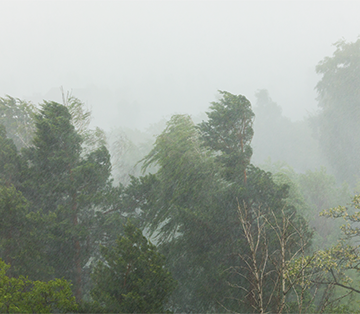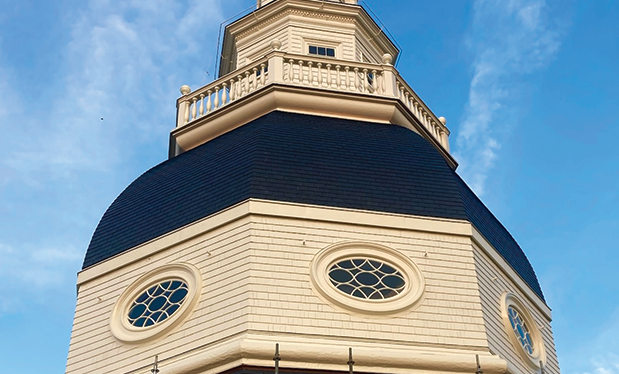
The International Building Code,® 2021 Edition and International Residential Code,® 2021 Edition require enhanced underlayment materials and application methods for asphalt shingle roof systems in certain situations, such as when installing them in low-slope applications or high-wind regions. Asphalt shingle roof system designers and installers should be aware of these enhancement requirements; highlights follow.
Low-slope applications
For asphalt shingle roofs with slopes between 2:12 and 4:14, IBC 2021 and IRC 2021 require a two-layer underlayment application. The underlayment is required to be applied as a 19-inch-wide starter parallel to and starting along the eaves. Next, full-width underlayment rolls must be applied shingle fashion starting at the eaves, overlapping successive sheets by 19 inches. End laps must be a minimum of 4 inches and offset by a minimum of 6 feet.
High-wind regions
IBC 2021 considers high-wind regions to be areas where the basic design wind speed is 140 mph or more. These areas include the Gulf of Mexico coastline; along the Atlantic coastline for Risk Categories II, III and IV buildings from Massachusetts to Florida; along the Alaskan coastline; and along portions of the Hawaiian coastline.
IRC 2021 considers residential buildings to be in a high-wind region when high-wind design, not IRC 2021’s prescriptive design, applies. IRC 2021’s high-wind design applies when the ultimate design wind speed is 140 mph or more.
When asphalt shingle roof systems are installed in high-wind regions, IBC 2021 and IRC 2021 require underlayment to be applied in two layers and comply with ASTM D226, “Standard Specification for Asphalt-Saturated Organic Felt Used in Roofing and Waterproofing,” Type II (No. 30); ASTM D4869, “Standard Specification for Asphalt-Saturated Organic Felt Underlayment Used in Steep Slope Roofing,” Type IV (No. 30); or ASTM D6757, “Standard Specification for Underlayment Felt Containing Inorganic Fibers Used in Steep-Slope Roofing.”
Underlayment must be applied as a 19-inch-wide starter parallel to and starting along the eaves. Next, full-width underlayment rolls must be applied shingle fashion starting at the eaves, overlapping successive sheets by 19 inches. End laps must be a minimum of 4 inches and offset by a minimum of 6 feet.
Underlayment also must be attached with corrosion-resistant, minimum 0.083-inch-diameter, annular ring- or deformed-shank cap nails in a grid pattern of 12 inches between side laps and 6-inch on-center spacing at side and end laps. Metal caps must be a minimum 1-inch diameter and have a thickness of no less than 32 gauge. Power-driven metal caps must be at least 0.010 inch thick. Plastic cap nails must be a minimum 1-inch diameter and have a minimum outside edge thickness of at least 0.035 of an inch. Cap nails must be long enough to penetrate not less than ¾ of an inch into roof sheathing.
As an alternative to the high-wind region, two-layer underlayment requirement, IRC 2021 permits a self-adhering polymer-modified bitumen underlayment complying with ASTM D1970, “Standard Specification for Self-Adhering Polymer Modified Bituminous Sheet Materials Used as Steep Roofing Underlayment for Ice Dam Protection,” to be applied according to the manufacturer’s installation instructions.
An additional alternative permits the use of minimum 4-inch-wide strips of self-adhering, polymer-modified bitumen underlayment to be applied over all joints in the roof deck sheathing followed by a single layer of underlayment. Attachment of the underlayment must comply with the code’s attachment requirements for high-wind regions.
Synthetic roof underlayments do not specifically comply with IBC 2021 and IRC 2021. However, NRCA’s code change proposals have been approved by the International Code Council,® so synthetic roof underlayments complying with ASTM D8257, “Standard Specification for Mechanically Attached Polymeric Roof Underlayment Used in Steep Slope Roofing,” will comply with the upcoming IBC 2024 and IRC 2024.
Closing thoughts
Specialized, enhanced underlayment requirements apply to asphalt shingle roof systems used in low-slope applications and high-wind regions. If you design or install asphalt shingle roof systems in these conditions, you should be aware of these required underlayment enhancements.
You should consult IBC 2021 and IRC 2021 for the specific code requirements applicable to asphalt shingle roof systems and other roof system types. Online versions of IBC and IRC are accessible at codes.iccsafe.org, and IBC 2021, IRC 2021 and previous editions can be purchased from shop.iccsafe.org.
Additional information about asphalt shingle roof systems is provided in the Asphalt Shingle Section of The NRCA Roofing Manual: Steep-slope Roof Systems—2021. This manual is available electronically to NRCA members free of charge; hard copies can be purchased from shop.nrca.net.
MARK S. GRAHAM is NRCA’s vice president of technical services.
@MarkGrahamNRCA
This column is part of Research + Tech. Click here to read additional stories from this section.



